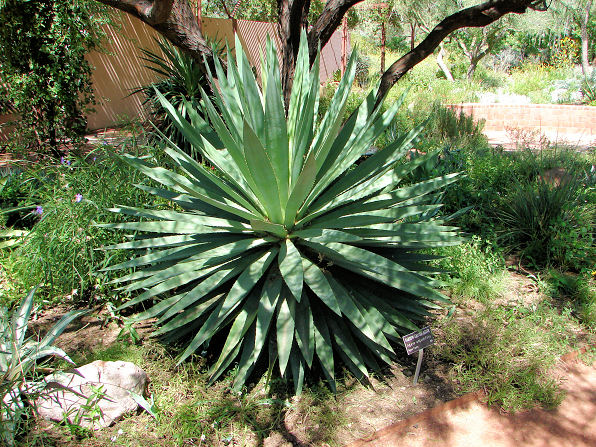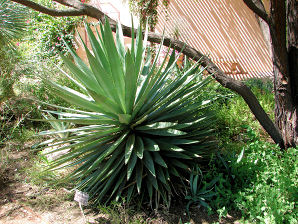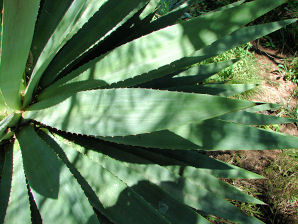Xeriscape Landscape Plants & Flowers
For The Arizona Desert Environment.
Pictures, Photos, Images, Descriptions, & Reviews.
Lechugilla Verde, Agave angustifolia.
We Are Proud Of Our SafeSurf Rating!
Click On Any Of The Following Links By Amazon.Com
For Books, & Videos About Wildflowers Of Arizona & The Southwest USA. No Obligation!
 |
| Lechugilla Verde, Agave angustifolia. Boyce Thompson Arboretum. Arizona. September 19, 2006. |
|---|
 |  |
| Lechugilla Verde. Agave angustifolia. | Maguey Lechugilla. Agave angustifolia. |
|---|
Lechugilla Verde.
We wish to thank Wikipedia, the free encyclopedia for some of the information on this page. We share images and information with Wikipedia. A thick-leafed evergreen succulent which dies after blooming. It has pointed leaves which form a basal rosette. It has a slow growth rate. It becomes very large. A small beautiful Agave with stiff short, sword shape leaves with cream colored margins. The leaves will reach up to 20 inches long by 3 - 4 inches wide with marginal teeth and a subulate-conical terminal spine. They are good container plants because of their small size. They freely sucker, so there is never a loss for new plants. Agave angustifolia need full sun to partial shade. Plants are very drought tolerant and will thrive even after some neglect. The plants should be watered and allowed to dry thoroughly before watering again. We fertilize only once during the growing season with a balanced fertilizer. During the winter months, only water enough to keep the leaves from shriveling. Agave angustifolia is propagated by using suckers, which often are found growing around the base of the plant, or by seed. The Agave 'Marginata' is similar to the regular angustifolia, but its leaves have a white margin.
Quick Notes:
Height: 3 to 4 feet tall. It spreads to about 4 feet.
Flowers: A large stalk emerges from the center of the plant, it becomes 10 to 16 feet tall. Then green to yellow flowers emerge from the terminal end on a horizontal branching structure growing up to 6 feet in diameter. The flowers are green to pale yellow, up to 3 5/8 inches long, with perianth segments erect, up to 1 1/4 inch long, the ovary is shorter than the perianth. Older Agave angustifolia can have a shorter stem.
Flowering Time: Phoenix Arizona, Mid March - April.
Leaves: The leaves symmetrical, a basal rosette, up to 4 feet long, nearly 4 inches wide, gray, curved or reflexed at the tip, margin toothed.
Found: Native Sonora and Tamaulipas, Mexico, south to Panama.
Hardiness:
Soil pH requirements:
Sun Exposure:
Elevation: 0 - 2,500 feet. In Arizona.
Habitat: Native in sand, sandy loam, clay and other heavy soils. It needs good drainage and aeration. It is remarkably tolerant of alkali. Hardy to 18� F.
Miscellaneous: Maintenance: Low. Good xeriscape plant. Photos Taken; Boyce Thompson Arboretum. September 19, 2006. Caution: There are numerous reports that people have been "burned" by its sap!
|
We Are Proud Of Our SafeSurf Rating!
Click On Any Of The Following Links By Amazon.Com
For Books, & Videos About Wildflowers Of Arizona & The Southwest USA. No Obligation!
| © 1966 - Present, Audrey, Eve, & George DeLange |
